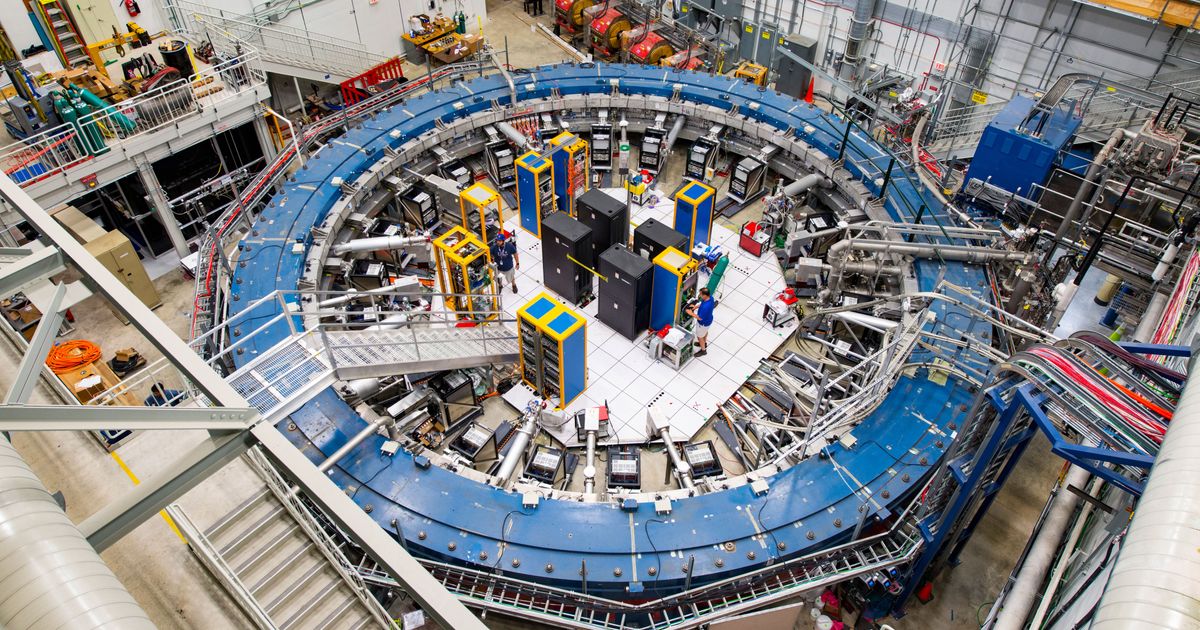Image: Reidar Hahn/FermiLab by means of United States Division of Power
On Wednesday, scientists with Fermilab, situated simply west of Chicago, introduced that an outcome 20 years planned can overthrow physicists’ understanding of exactly how deep space functions.
They launched the very first outcomes of the Muon g-2 experiment, which considering that 2018 has actually determined a larger relative of an electron called the muon. Muons rotate in an electromagnetic field, and also various other subatomic fragments impact exactly how they relocate. The more powerful an electromagnetic field, the much faster a muon totters. By observing the spin, researchers can determine exactly how quick the muons are tottering. However when the experiment was run, scientists located that the muons may be ever before so a little a lot more magnetic than concept anticipates. The abnormality is tiny– simply 2.5 components in 1 billion– yet it might suffice to call for a description wherefore’s triggering the much faster totter in the type of totally brand-new fundamental particles. If that took place, it would certainly test the Requirement Design of bit physics, a rulebook for exactly how deep space functions.
” My impression is ‘Wow,'” Gordan Krnjaic, an academic physicist at Fermilab that was not associated with the study, informed Scientific American “It’s practically the most effective feasible situation circumstance for speculators like us. I’m assuming a lot more that it’s perhaps brand-new physics, and also it has effects for future experiments and also for feasible links to dark issue.”
Muons were an interested difficulty to the or else restricted actors of subatomic fragments when they were uncovered in the 1930 s. (After they were located in planetary rays, it so puzzled researchers that a physicist notoriously asked, “ That got that?”) Certainly, study recommends there may be something odd regarding muons. Back in 2001, an earlier run of the Muon g-2 experiment at Brookhaven National Research laboratory located a small disparity in between experiment and also concept. However the experiment really did not take sufficient information and also disappointed the crucial limit called for to assert exploration. Therefore, after 10 years, Fermilab made a decision to get the search. And also this moment, physicists would certainly rerun the try out a more powerful muon light beam.
Physicists built a ring of magnets in the form of a Hula-Hoop, 50 feet throughout and also 6 feet high, developed to determine exactly how fragments totter like a failing rotating leading in the visibility of an electromagnetic field. Researchers blew up fragments around an allured track that maintains them around enough time, little split seconds, for scientists to obtain a more detailed take a look at them.
There is presently a 1 in 40,000 opportunity that Fermilab’s outcome can merely be a fluke, corresponding to an analytical degree of self-confidence referred to as 4.1 sigma. By the stringent criteria of bit physics, a degree of 5 sigma, or a 1 in 3.5 million opportunity of the monitoring being a coincidence, is required to assert a “exploration.”
Scientists that worked with the Muon g-2 experiment require one more year or more to end up assessing the outcomes of every one of the laps around the track. “Up until now, we have actually just assessed 6% of the information, and also when we integrate the outcomes of every one of the runs, we’ll obtain an also much better dimension,” Sudeshna Ganguly, associate researcher at Fermilab, informed Gizmodo “It’s incredibly amazing to be a component of this.”
